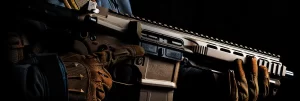When it comes to gun control, many people can understand restricting weapons that pose a particularly high threat to the population. Examples of these weapons include machine guns, sawed-off shotguns, and short-barreled rifles. For each of these items, a feature of the weapon has proven them to be especially dangerous.
Machine guns
In the case of machine guns, the automatic fire of bullets allows the operator to spray projectiles with a single pull of the trigger, reducing the need for accuracy and increasing the killing potential exponentially as opposed to the single pull, single bullet mechanism of a semi-automatic gun or revolver.
SBR
Sawing off the end of a shotgun causes pellets to spray out in a haphazard fashion, but studies show that they do not cause significantly more damage to a target than a regular shotgun. The danger of a shortened shotgun and rifle lies in the ability to conceal the weapon. A full-sized shotgun or rifle would be impossible to hide, even in a long coat, but a short one could be easily hidden. For that reason, ownership of these items is restricted under the National Firearms Act. When it comes to accessories, however, the case for inclusion in the act becomes murkier.
Bump Stocks
Bump stocks garnered national attention in 2017 following a mass shooting in Las Vegas. In this instance, the perpetrator used a bump stock to change the operation of his AR-15 rifle. The accessory allowed him to spray bullets into a huge crowd of people attending a concert, killing 58 and wounding hundreds. The Trump administration announced a ban on bump stocks a year later, requiring that those items currently in possession be relinquished or destroyed.
Although the bump stock is merely an accessory, the use of it in conjunction with an AR-15 yields an automatic weapon. Because this stock makes the weapon infinitely more dangerous, its inclusion in the National Firearms Act seems logical. However, gun enthusiasts often question why suppressors are included. Are they not simply devices to reduce sound?
Suppressor’s
Hunters have long contended that use of a suppressor for hunting rifles and shotguns is a necessity for the health of the shooter. Indeed, deafness is a real threat to lifelong hunters and firearms competitors. Suppressors have been shown to dampen sound to the same level as wearing noise-cancelling headsets. Suppressors do not make any weapon more lethal; they do not affect the way the bullet is released or increase the damage caused by the shot.
They do, however, suffer from a public perception problem. In the early days of suppressors, they were used in several high-profile crimes in New York, where the media began to call them “silent killers.” Their popularity with famous gangsters and organized crime in the 1920s solidified their reputation as illicit and a danger to law enforcement as well as the public at large. Hollywood’s depiction of suppressors as the primary tool for assassins added yet another layer of discrimination to the accessory.
Hearing protection act
Despite their high-profile reputation, ATF data proves that silencers are rarely used in crimes. Advocates of their removal from the National Firearms Act contend that suppressors have been unfairly targeted and prove no threat to the public. In an era of ever-increasing mass shootings, however, opponents of easing restrictions point to the importance of hearing a shot for saving lives quickly in the case of a mass shooting event. In early 2023, the Hearing Protection Act was reintroduced in the Senate by Idaho Republicans Jim Risch and Mike Crapo.
The original version of the HPA was introduced in 2015 and was derailed by both a shooting at a congressional baseball game the day it was scheduled to be voted upon, and the fallout from the 2017 Las Vegas mass shooting. Since then, with mass shooting events occurring with staggering regularity, political will to ease gun restrictions has remained at an all-time low.
For now, suppressors are legal in 42 states and require a tax stamp from the ATF for their possession and use. As with other items under the National Firearms Act, they require a $200 fee and a long wait for approval. It remains to be seen if the new version of the Hearing Protection Act will gain ground in the Senate. Even with its passage, however, it is unlikely that deregulation would remove the social stigma of the suppressor.



 How to Make Changes to a Gun Trust
How to Make Changes to a Gun Trust